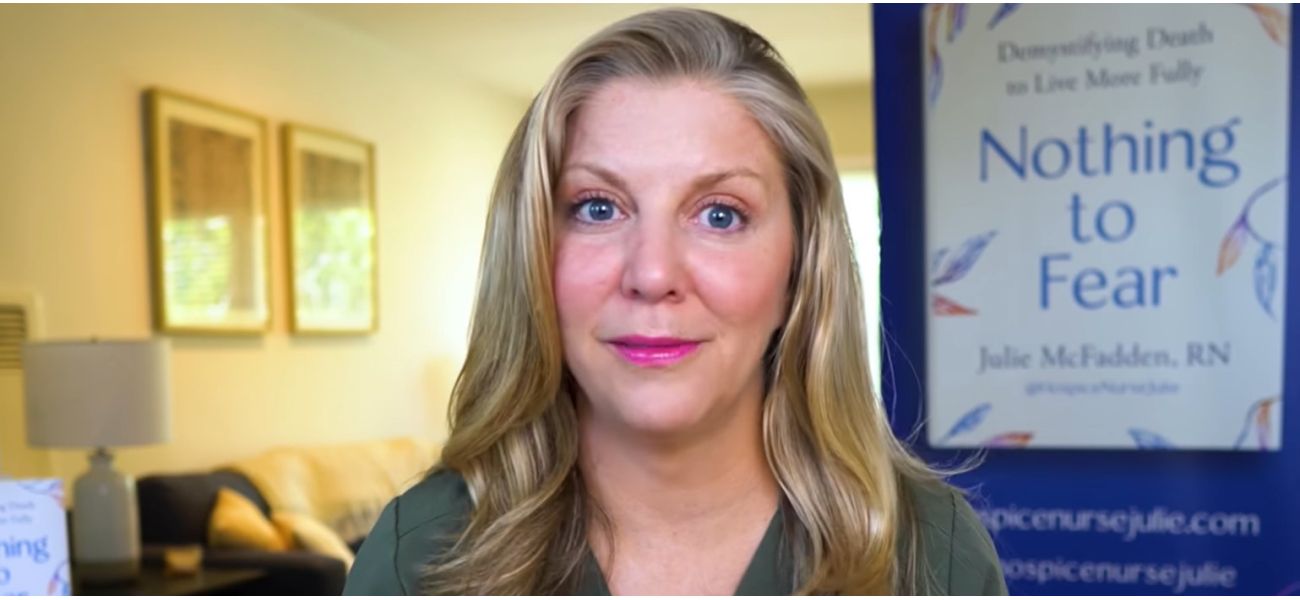Hospice nurse shares what occurs after death
Julie McFadden wants to educate people to lessen their fear of death.
November 12th 2024.

Julie has a passion for educating people about death and dying. Having worked as a nurse in an intensive care unit, she has seen a lot of death throughout her career. However, she noticed that while she would often discuss the likelihood of her patients passing away with her colleagues, she rarely had these conversations directly with the patients or their families.
This realization inspired Julie to start advocating for her patients and speaking up about death. She eventually transitioned into hospice nursing, where she witnessed the natural process of dying and found it to be a beautiful experience. Her passion for demystifying death also led her to write a book and create videos on her YouTube channel where she discusses death and dying and advocates for patients and their families.
One of her most popular videos, which has been viewed nearly 600,000 times, explains exactly what happens to the human body after death. Julie hopes that by sharing this information, she can alleviate some of the fear and uncertainty surrounding death.
In hospice care, the main focus is on making patients comfortable in their last months of life. After death, the body goes through different stages of decomposition. In the first stage, the body completely relaxes, causing the release of fluids and waste. This can sometimes be messy, but Julie believes it's important for people to be aware of this process so they won't be caught off guard.
The next stage is a drop in body temperature, which eventually matches the temperature of the room the body is in. Then, the blood starts to pool downwards due to gravity, causing discoloration on the back of the body. The body also goes through rigor mortis, where the muscles stiffen due to the lack of ATP, the body's cellular energy.
Julie explains that everyone experiences rigor mortis differently, and it can start as soon as a few minutes after death or take longer to set in. This stiffness usually lasts for 24-36 hours before loosening again. During this time, the body also becomes very heavy, making it difficult for one person to move or clean without help.
After a day or so, the body will start to loosen as the tissues relax. At this point, the body is typically taken to a mortuary to be prepared for the next steps, such as embalming, cremation, or burial, according to the person's final wishes or their family's decision.
Julie emphasizes the importance of knowing what one wants for their remains after death. She explains that the body will naturally decompose over time, going through four stages. The first stage, hypostasis, happens in the first one to two hours after death, while the second stage, algar mortis, occurs as the body cools to match the room's temperature.
The third stage, autolysis, is when enzymes start to break down the tissue. This process begins just a few minutes after death. Finally, the last stage is putrefaction, which starts between four to 10 days after death and involves the release of gases. Julie notes that this is a normal process, but we are not often exposed to it in our daily lives.
In conclusion, Julie believes that it's crucial for people to have discussions about death and dying and to know what they want for their remains after they pass away. She encourages individuals to explore the different options available and to be informed about the natural process of death and decomposition.
This realization inspired Julie to start advocating for her patients and speaking up about death. She eventually transitioned into hospice nursing, where she witnessed the natural process of dying and found it to be a beautiful experience. Her passion for demystifying death also led her to write a book and create videos on her YouTube channel where she discusses death and dying and advocates for patients and their families.
One of her most popular videos, which has been viewed nearly 600,000 times, explains exactly what happens to the human body after death. Julie hopes that by sharing this information, she can alleviate some of the fear and uncertainty surrounding death.
In hospice care, the main focus is on making patients comfortable in their last months of life. After death, the body goes through different stages of decomposition. In the first stage, the body completely relaxes, causing the release of fluids and waste. This can sometimes be messy, but Julie believes it's important for people to be aware of this process so they won't be caught off guard.
The next stage is a drop in body temperature, which eventually matches the temperature of the room the body is in. Then, the blood starts to pool downwards due to gravity, causing discoloration on the back of the body. The body also goes through rigor mortis, where the muscles stiffen due to the lack of ATP, the body's cellular energy.
Julie explains that everyone experiences rigor mortis differently, and it can start as soon as a few minutes after death or take longer to set in. This stiffness usually lasts for 24-36 hours before loosening again. During this time, the body also becomes very heavy, making it difficult for one person to move or clean without help.
After a day or so, the body will start to loosen as the tissues relax. At this point, the body is typically taken to a mortuary to be prepared for the next steps, such as embalming, cremation, or burial, according to the person's final wishes or their family's decision.
Julie emphasizes the importance of knowing what one wants for their remains after death. She explains that the body will naturally decompose over time, going through four stages. The first stage, hypostasis, happens in the first one to two hours after death, while the second stage, algar mortis, occurs as the body cools to match the room's temperature.
The third stage, autolysis, is when enzymes start to break down the tissue. This process begins just a few minutes after death. Finally, the last stage is putrefaction, which starts between four to 10 days after death and involves the release of gases. Julie notes that this is a normal process, but we are not often exposed to it in our daily lives.
In conclusion, Julie believes that it's crucial for people to have discussions about death and dying and to know what they want for their remains after they pass away. She encourages individuals to explore the different options available and to be informed about the natural process of death and decomposition.
[This article has been trending online recently and has been generated with AI. Your feed is customized.]
[Generative AI is experimental.]
0
0
Submit Comment





